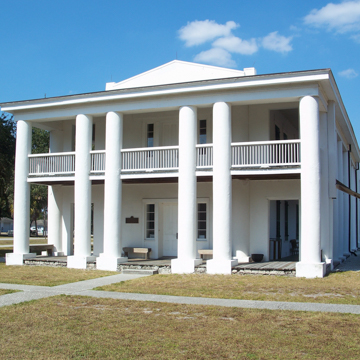You are here
Judah P. Benjamin Memorial
The Gamble Mansion is the oldest building on the west coast of Florida, as well as the only surviving plantation house in Peninsular Florida, and the only Confederate memorial in Florida. It is now known as the Judah P. Benjamin Memorial, named after the Confederate Secretary of State who took refuge in the house as he fled the United States for England at the close of the Civil War. After his arrival in Great Britain, Benjamin, a noted Jewish lawyer, eventually rose to be a member of the Queen’s Counsel.
Aligned with the cardinal axes, the building is nearly completely enveloped by deep verandas created by two-story colonnades of paired white columns set on block bases and devoid of capitals on the east, west, and south sides. Open-air passageways separate a northern block of four rooms from the rest of the colonnaded structure, where the parlor, dining room, and guest rooms were located. This northern wing contained a work room and kitchen on the ground floor, and a “slaves’ sewing room” and bedroom on the second floor.
The original materials in the house point to the ways that building construction in the rural south, even for structures of pretense, relied upon local materials to create the easily recognizable Georgian architectural style. Here, the columns and the walls of the northern block are made from a locally formed tabby, a concrete brick made from oyster shells and set into an oyster shell-based mortar, materials for which were mined from the many Native American middens (like Turtle Mound) that dotted the Florida coasts. Enslaved laborers created the tabby bricks to build the mill, slave quarters, and other buildings that supported the production of sugar on the plantations bound for markets in New Orleans.
The building was constructed by Robert Gamble in the middle of what, in its heyday, was a 3,400-acre sugar plantation, containing a large mill, cisterns, at least 190 slaves in 57 slave houses, and the navigable Manatee River running through it, which aided in transporting the sugar to New Orleans. Gamble was granted the property free of charge under the Florida Armed Occupation and Settlement Act of 1842, which was designed to settle remote areas of Florida—to which the last of the Seminoles retreated after the Second Seminole War—with an armed militia of new landowners ready to fight if needed. Under financial stress, Gamble deeded the property to its second owners in 1857 and the property passed through many hands until it was purchased by the United Daughters of the Confederacy in 1925, and shortly thereafter passed to the State of Florida. The property was severely damaged in the hurricane of 1926 and the process of its restoration and reuse as a memorial has left it in a configuration similar to the original, but with very few original details. Its complex, multilayered history is represented by its current name: Judah P. Benjamin Confederate Memorial at Gamble Plantation Historic State Park.
References
Schuck, J. P., “Gamble Mansion (Judah P. Benjamin Memorial),” Manatee County, Florida. National Register of Historic Places Inventory–Nomination Form, 1970. National Park Service, U.S. Department of the Interior, Washington, D.C.
Silpa, Felicia Bianca. “Reflections of Virginia on the Manatee River.” Historical Archaeology46 (1) (2012): 74–93.
Writing Credits
If SAH Archipedia has been useful to you, please consider supporting it.
SAH Archipedia tells the story of the United States through its buildings, landscapes, and cities. This freely available resource empowers the public with authoritative knowledge that deepens their understanding and appreciation of the built environment. But the Society of Architectural Historians, which created SAH Archipedia with University of Virginia Press, needs your support to maintain the high-caliber research, writing, photography, cartography, editing, design, and programming that make SAH Archipedia a trusted online resource available to all who value the history of place, heritage tourism, and learning.










